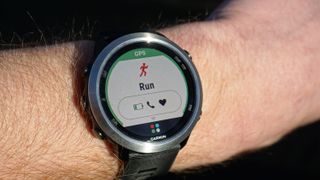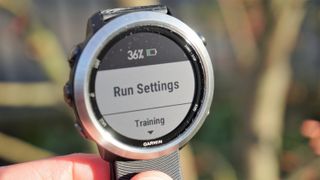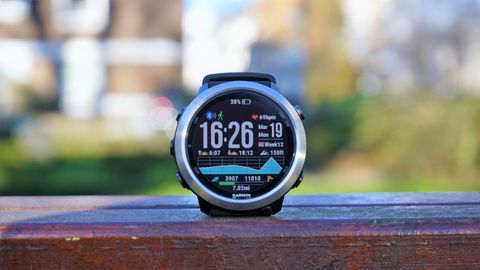Why you can trust TechRadar
- Loads of fitness options
- GPS is rapid
- Swimming, yoga and paddle boarding on there too
Take away the (admittedly useful) gimmick of music playback and you’re still left with a Garmin sports tracking watch - and like the other members of this family, it’s excellent in this regard.
Once again eschewing the touchscreen, everything you do with the Forerunner 645 is through the buttons around the watch, and it means it’s very easy to start, stop and flick through exercise data at any point.

The heart rate monitor on your wrist is one of the more accurate we’ve tested… so much so that we didn’t ever feel the need to use a strap on our chest when out testing.
When testing the Forerunner 645 in extremely cold weather, we did find that it struggled to pick up our pulse, so if that’s going to be a regular for you then we suggest you invest in a chest strap.
This also unlocks some more of the running dynamics that some might like, such as ground contact time and vertical oscillation. Honestly, we rarely use this feature despite it being rather interesting to see your actual metrics, like which foot impacts harder each stride.
Unless you’re training very specifically and have a coach, we’d say you can skip buying the heart rate monitor or foot pod you need to enable this.

One thing you will like with the Forerunner 645… the GPS is rapid to lock. Seriously, one of the best we’ve seen and even without being constantly connected to your smartphone.
If you’ve not had your phone synced for a while it can take a little longer (in a new built up area with no phone connection it took nearly two minutes, but the next time was instant), so if you’re in a recognisable or open area we’re talking a few seconds before you’re off and running. It’s excellent.
You can also create interval sessions right from the watch too, which is nice if you’re in the mood for something a little more advanced - and there are little beeps that count down when you’re about to move into the next phase.
Sadly these don’t translate to audio in connected headphones, but you do get your laptimes if you’ve got the feature enabled - on a twenty mile run it’s nice to have someone soothingly telling you your last mile time, although it can get a bit mixed up and robotic.
If you want something a bit more technical in your workout, you can set a session directly from your phone and sync it right to the watch - perfect if you want to do sprint repeats followed by a long run, or switch between power and pace on the bike.
Running

The main thing we used the Garmin Forerunner 645 Music for during our testing is the running capabilities - and it’s pretty darn good for them.
It’s not a lot different in look or function to the Forerunner 935 or the Fenix 5X, with the ability to see your heart rate, distance, pace, time, averages of all the above and even the time the sun is going to rise and set.
In short, there’s very little that can’t be shown on this watch when you’re running, and customising your screens to what you like to see can be done in seconds, as we found just before beginning and realizing that we’d put in actual pace rather than average pace a data field.
The accuracy of the GPS was pretty good - perhaps a little generous over a longer run, with two long runs of 18 and 20 miles showed us running 1% further than the measured distance.
It’s not big deal, but in a marathon that 0.2 extra bit of a mile can be a bit disconcerting if you’re trying to run to a specific pace, although we didn’t find it a tremendous problem.
Over shorter distances it was fine, and treadmill running proved pretty accurate too - after your first session you’ll ‘teach’ the watch how far you’ve gone and it’ll offer better distances form that.
Cycling

One of the nice things about Garmin watches is their compatibility - while there’s still too much reliance on Ant+ sensors (the old version of connectivity before Bluetooth), the fact both Bluetooth and Ant+ are supported means pretty much any cycling accessory can be connected.
That means power meters, turbo trainers, bike lights and even cameras can be operated from your watch on the go, and that’s pretty easy given the large screen and simple-to-press buttons.
Just like the running mode, there’s not a lot to really say here other than it worked fine, the screen is bright and legible and having that audio feedback on a cycle is even better than on a run, as you can less easily glance at the display when cycling along.
The heart rate monitor also stayed pretty true during our pedalling, reacting well to changes in effort and helping us push harder in the interval sessions we set up from the Forerunner 645.
Strength training

It’s really great that so many watch manufacturers are trying to track gym efforts, and Garmin recently introduced the same thing.
The idea is that the watch uses the accelerometer to read the motion of each exercise, something called its ‘fitness envelope’, and then count how many of those motions you’ve done.
You can then set how heavy the weight is afterwards, thus giving an accurate measure of how hard you’ve worked.
It’s a nice idea....it doesn’t work. The rep counting is so often off unless you’re doing the motion very slowly and to the exact parameters each time, which many can’t manage nor want to do.
In order to preserve the fitness envelope Garmin recommends you don’t look at the watch during the set, so the motion is consistent - so you can’t even check how many reps you’ve done.
It’s also a little irritating having to enter the weight using the up / down keys every time, so in the end we just stopped using the feature.
The rest timer on there is pretty good though, allowing you to make sure you’re allowing enough time between each action - and you can see each element after.
You can even pre-prepare your workout on your phone, coding in the exact exercise you want to do (and there are loads listed on the Garmin database) and it’s nice to just plug in and go.
However, you’ll need to be quick to spot which exercise is coming up, as it doesn’t stay on the screen long and there’s no way to call it back up.
The Garmin Forerunner 645 Music is only any good for strength training if you’re willing to correct the number of reps and weight after each set - and it’s just too much hassle.
That said, it’s nice not to have to carry your phone around to listen to music.
Other exercises

It’s rather impressive what other exercises the 645 Music can track, thanks to the accelerometer and altimeter being able to assess motion and elevation.
You can ski and snowboard, or swim in a pool and have the lengths and distance tracked. However, open water swimmingg isn’t allowed for some reason, despite all the right sensors being in there, and inexplicably there’s no triathlon mode.
Given that last mode is just being able to stitch together a swim, run and cycle into one activity, with transition timers in between, it’s very strange Garmin hasn’t added it in.
Paddle boarding, yoga, step / elliptical / rowing machines in the gym are all supported too - while not perfect thanks to some weird omissions listed above, the Forerunner 645 is generally a very good sports tracker.

Gareth has been part of the consumer technology world in a career spanning three decades. He started life as a staff writer on the fledgling TechRadar, and has grown with the site (primarily as phones, tablets and wearables editor) until becoming Global Editor in Chief in 2018. Gareth has written over 4,000 articles for TechRadar, has contributed expert insight to a number of other publications, chaired panels on zeitgeist technologies, presented at the Gadget Show Live as well as representing the brand on TV and radio for multiple channels including Sky, BBC, ITV and Al-Jazeera. Passionate about fitness, he can bore anyone rigid about stress management, sleep tracking, heart rate variance as well as bemoaning something about the latest iPhone, Galaxy or OLED TV.

Inside the company making 35-year-old Game Boys look and work like new

AMD teams up with Arm to unveil AI chip family that does preprocessing, inference and postprocessing on one silicon — but you will have to wait more than 12 months to get actual products

The US takes another big step towards banning TikTok – here's what you need to know
